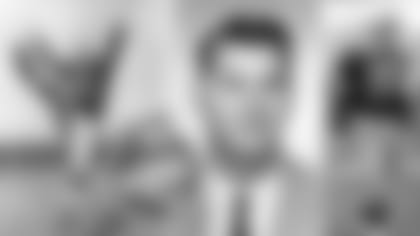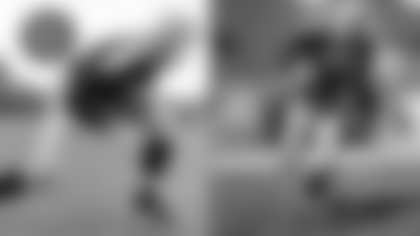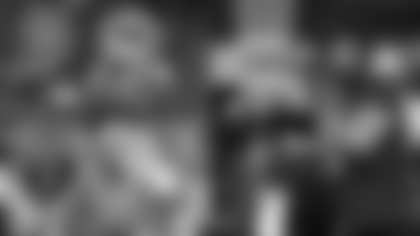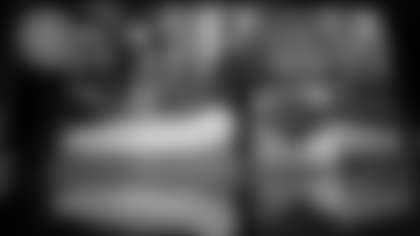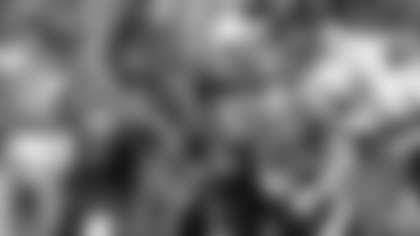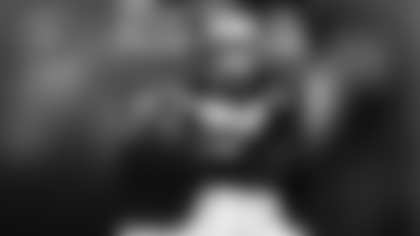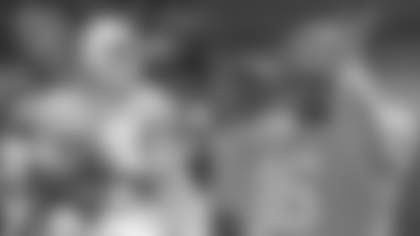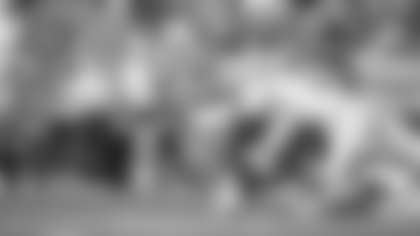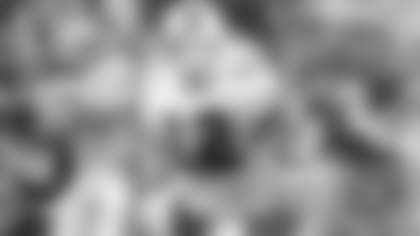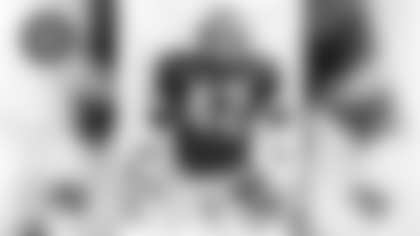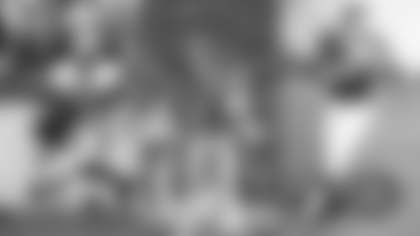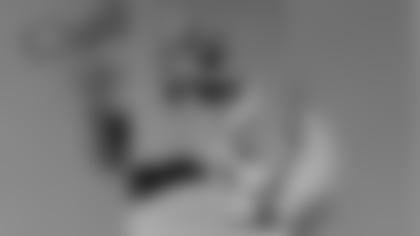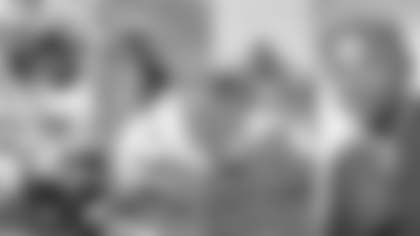*Cliff Christl started gathering oral histories with former Packers and others associated with the team in 2000 and will continue to gather them as Packers historian. Excerpts from those interviews will be periodically posted at **www.packers.com*
Dick Deschaine, who never attended college, served as the Packers' punter from 1955 to 1957 and was essentially the first kicking specialist in team history. In his first two seasons, the NFL roster limit was 33 before it was increased to 35 in 1957. Thus, Deschaine, who stood 6-foot-2 and weighed 210 pounds, was also the Packers' third offensive end his first two seasons, although he never caught a pass in a regular-season game. Deschaine's punting average in Green Bay was 42.6 yards. He finished second in the NFL in punting his first two seasons and sixth in his third year. "He certainly is a natural punter and one of the finest kickers I have seen in this league," Jack Vainisi, Packers talent scout at the time, wrote in a letter in 1956. The Packers traded Deschaine to the Cleveland Browns for a draft choice four days before the 1958 opener. He punted one year for the Browns, finished sixth in the league, and was cut the next year. A native of Menominee, Mich., Deschaine was a high school football star there, graduating in 1949, and later played semipro ball for the Marinette-Menominee Hornets, members of the Wisconsin State Football League. The Packers signed Deschaine after Max McGee, their punter in 1954, was called into service.
On why he didn't play college football: "I went in the Marines."
On playing for the M&M Hornets: "It was a semipro team. Nobody got paid, but I did. I got $50 a game. The Manitowoc Chiefs, I believe, were one of the teams we played. We even played the state prison in Marquette (Mich.). All the lifers were there, but the M&M Hornets were asked to play them so we did and we beat them. The funny thing was that after I joined the Packers one of the first notes I got was, 'Congratulations, Dick. Wish you well from all the players at the Marquette state prison.'"
On how he got his tryout with the Packers a month into training camp in 1955: "I was working for the Ansul Chemical Co. at the time. I heard the Packers needed a punter really bad. Somebody wrote a note to Liz Blackbourn, the head coach at the time, saying, 'We've got a guy who works with us here who can really punt the ball.' They responded to the letter and I had a tryout immediately. The tryout was in Stevens Point, where we had our training camp. I tried out at Bukolt Park (there) and had it made right away."
On his punting background: "I had no training as far as punting. It all came natural."
On whether he got any coaching in the pros:"No. Scooter McLean worked with me as far as an offensive end. But I had no coaching as far as punting the ball. None whatsoever."
On doubling as an offensive end: "We only carried (33), 35 ballplayers then for the Packers. You had to make the team other than just punting. So I was the third end. We had Gary Knafelc, Bill Howton and myself."
On whether he was more a tight end or split receiver: "We ran the T-formation, the old-fashioned T. It was very simple. Tobin (Rote) was always under center, more or less. The halfbacks were one on each side of the fullback. The fullback was behind the quarterback. The two ends weren't tight ends, but they were closer to the inside than the outside, as I recall. I'd be maybe three steps out from the right tackle. Maybe they had some specials for Howton (as a split receiver). He was pretty quick."
On Blackbourn, the Packers' head coach from 1954-57: "He liked me a lot. That's why I liked him. I'll never forget, he said, 'Hey Dick, you're doing a heck of a job.' He told me I was the best punter he had ever seen in his life. He was a (darn) good coach. You go back and look 10 years later (after he got fired) and what guys did, the Packers won because of him and his drafting."
On Blackbourn's issues with other players: "Fundamentally, he was very good… But he was always off by himself, it seemed… Yeah, (other players) called him, 'The Lizard.' He was very serious. He was a disciplinarian, but didn't yell or scream much. Paul Brown was a much tougher coach in Cleveland."
On Vainisi: "Jack Vainisi was quite a guy. I liked him and he liked me a lot."
On Rote, the Packers' starting quarterback in 1955 and '56:"He was a big guy. He could run the ball. But they expected so much out of him, he was doing everything. He was a very good leader. Had a very strong arm. He was kind of clumsy fast. He just loved to run. He could throw the ball easily 70 yards."
On Babe Parilli, who shared quarterback duties with Bart Starr in 1957: "He was quite a ball-handler. He really knew how to fake people out. Very, very good arm. Not as good as Tobin's. I'd say Babe had more potential (than Starr). He threw the ball better. I don't know how Bart made it. Did you know he was the No. 1 punter in college? He saw me punt and he just walked away."
On Charlie Brackins, one of the NFL's first African-American quarterbacks who threw two passes for the Packers in 1955 before being cut: "They found him about 4 o'clock in the morning drunk in Chicago, passed out. He kicked off (against the Bears) and then they got rid of him on the train. He had all the qualifications, but he screwed up."
On halfback Al Carmichael, a Packers Hall of Famer who played from 1953-58: "He was fast. He set a record against the Bears, 106 yards on a kickoff return. It didn't seem like he was going that fast, but he was always beating everybody. Nobody could catch him."
On halfback Veryl Switzer, who played from 1954-55, missed two seasons while he was in the Air Force and was waived when he returned in 1958: "He was quick. Small, but a hard runner. When he came back from service, he didn't make the team he was so far out of shape."
On kicker-fullback Fred Cone, a Packers Hall of Famer who played from 1951-57:"Great placekicker. No, not much of a runner."
On fullback Howie Ferguson, a Packers Hall of Famer who played from 1953-58: "He was a tough, tough runner. He was the best around at the time except for the guy from Wisconsin, 'Horse' Ameche. Fergie always thought he could beat him and I guess (Ameche) thought the same way. Ferguson was from Louisiana and he was just a tough, tough dude. He liked to hurt people."
On halfback Joe Johnson, who played from 1954-58: "He wasn't great at anything, but a good utility man. Very good receiver. Not fast. He played in the backfield."
On middle linebacker Tom Bettis, who started ahead of Ray Nitschke in 1958, '59 and for parts of the 1960 and '61 seasons: "He was very good. He was a No. 1 draft choice (in 1956). Strong. Heavy-duty guy. Bettis was much better than No. 66, by far. Nitschke thought he was so good and was always bragging about this and that, but he didn't accomplish anything the first few years. He turned out to be a great one, but it took him quite awhile to learn the system."
On his memories of old City Stadium, the Packers' home from 1925-56: "The showers, sometimes they worked, sometimes they didn't work. You know how old that place was? It was just unreal."
On Dedication Weekend for what is now Lambeau Field: "That was quite a ceremony. We played the Bears on Sunday. On Saturday, we got dressed up and made a tour of Green Bay in convertibles. I was next to Matt Dillon (star of the TV program, "Gunsmoke") in the backseat. He had a six-gun with a high hat. Miss America. We met them all. I met the vice president, Richard Nixon. He came down after the game and I was always the last dog to leave. I was showering and whistling and happy and everything. All of a sudden, 'Deschaine get out here quick. There's somebody here to see you.' I run out there bare-(butt) and guess who is there? Richard Nixon. He says, 'Dick Deschaine?' I said, 'Yes.' He said, 'Congratulations. You did a hell of a job.'"
On Scooter McLean, assistant coach from 1951-57 and head coach in 1958: "His health was really bad. He had ulcers from day one. All he could drink was milk. We kind of felt sorry for him. He'd throw up a lot, too. He worked me for three years. He was in charge of the ends. We liked him. He was a good teacher."
On McLean's coaching style: "Nonchalant. He was more or less a buddy. If you walked by him, he'd start a conversation. Very, very friendly with the players. He was well liked. He'd play cards in the dormitory at training camp, stop in and (shoot the) bull."
On training camp in Stevens Point: "Stayed in a dorm. We'd be bussed (to practice). They'd feed us there. The curfew was 10 o'clock. We had a chalk talk after we ate. We practiced morning and afternoon, ate, chalk talk, 7 to 8. Then we'd have a couple of hours to relax and have a couple beers."
On players staying at the YMCA in Green Bay in those years: "We were all there. I lived at the Y. But I was born and raised in Menominee, Mich., so after the game, I'd go right home. Most of the players stayed at the Y until they made the team and then they were on their own. I got apartments after I made the team. One was on Stuart Street. Maybe Roscoe Street (another season)."
On the players' favorite hangouts in Green Bay: "I used to go to the Piccadilly all the time. (Paul) Hornung, Max McGee, all those guys. They did it up big at the Piccadilly. It was just a lot of fun. It was a dance bar. They had strippers in there. No heavy drinking. Just a couple beers when you were really thirsty. We used to go a lot to (what was later) the old Carlton on the bay, too. Boy, they had (good) food. On Sunday night, they kept it open just for the Packer players. Just the players and their wives or their girlfriends would go out there."
On road trips: "We'd have to pack for a couple weeks to go out to the coast to play the 49ers and Rams. Guess how we got there? By train. A (gosh darn) train that stopped every place along the way. It took us three days to get there. We'd play cards, have a couple beers. We had our own car. Don't forget, we had only 35 ballplayers. We stayed in the train and they had a sleeping area for us. It took a long time and then we had to go back home that way."
On what it was like on trips when they flew to games: "We had an exhibition game in Charleston, W. Va. (in 1955). The airplanes were so small, we had to take two aircraft and I think our equipment got lost. We were running around with no pads or anything. I think we stayed there for two weeks and we had to wait three, four days until they found us our gear."
On getting traded to Cleveland in 1958: "When I got traded to Cleveland, it was between me and (Jim) Taylor (a rookie that year). He was so strong, but they'd tell him to go through the No. 2 hole and he'd run through the No. 4 hole or 6 hole. He couldn't get the system. He was a (darn) good ballplayer, but everything took so long for him to understand. They were really thinking about getting rid of him. But I was the last one to leave to make room for him."
On getting cut by the Browns in 1959: "I got hurt in a preseason game. I tackled somebody and a cleat hit me in the leg. That night it blew up and the next day I had it operated on. I couldn't do anything for two weeks and I was just a punter. I didn't know this, but Paul Brown told people I had a broken leg. Weeb Ewbank (coach) of the Colts called and said, 'Dick, I hear you have a broken leg.' I said, 'Who told you that?' He said, 'That's the word around the National Football League.' I said, 'No way. I'm fine. I could play right now.' He said, 'Well, why don't you come? We'll get you on a train.' I said, 'Listen, I've got a good job. I'm working for Miller Brewing Co.' I had a couple kids, married and the money wasn't there. So I said, 'Forget it.' You know what happened? They (the Colts) won the championship with Johnny Unitas and that bunch. I should have been there."
Deschaine, 85, lives in Green Bay. When his pro career was over, he settled in Green Bay and worked for car dealerships for more than 30 years. He also was a standout in fast-pitch softball, when that was a popular men's sport and Green Bay had some of the best amateur teams in the Midwest. The excerpts above were taken from interviews conducted in 2005 and last week.
- *



